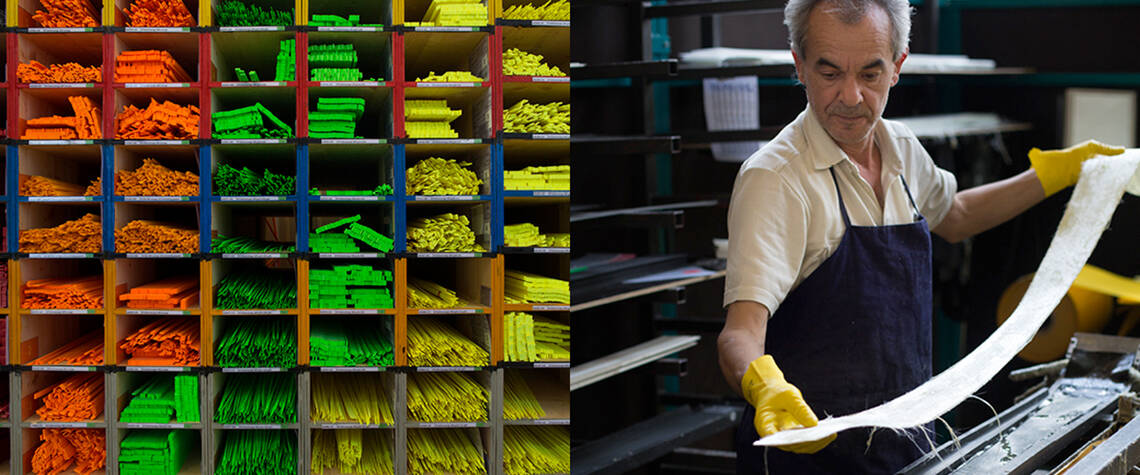
REPORT
This will become a ski
Every detail must be perfect when producing skis. Including the emblems. A factory visit in Mittersill, where fast boards mean the world.
At first, the scene is confusing. The large hall in the basement of the Blizzard production in Mittersill is empty and deserted. Everything looks like it has not been used for a long time. Light only penetrates through cloudy windows on one side of the room. Silence.
But for Blizzard man Thorsten Steiner, the empty hall is a good sign. The company, which has been one of the best ski manufacturers in the world for more than 70 years, has completely converted to lean production. This means it will seek to avoid all unnecessary paths, steps, and materials. Now the only things that will be stored are things that will be soon processed - including the different components from the RATHGEBER Group. "Materials that just sit around the place cost money. We want to avoid this," said Steiner. Things will only be delivered at the last minute. Accordingly, less space is needed.
What this means can be seen on on the ground floor of the factory. The mood is very different here: In the huge hall workstations for the individual production steps are lined up. It roars and hisses, electric carts meander through the halls with their followers and supply the individual workspaces with replenishment.
In summary, ski production works like this: The individual parts for an item are prepared, stacked, and then pressed together in a mould under a lot of pressure and heat. Finally, excess material is cut, the ski is ground - and finished. In truth, the whole process is much more complicated; organising the processes alone is a true Sisyphean task.
The process begins in the raw material warehouse right next to the production factory. Several tonnes of material are delivered, restructured, and prepared for production here every day. On one side of the warehouse wooden slats are stacked, finely layered on pallets, almost up to the roof. It is cool in the warehouse, almost a little uncomfortable. The temperature is ideal for wood. "Wood is alive. Until we press and glue it, it's working," says Steiner. Wood is still the material with the largest volume share in skiis. The core essentially determines how the ski will subsequently work.
Carbon, titanal – and still mainly wood
The wood cores differ extremely depending on the ski. Whether lighter cross-country skis, more comfortable slope cruisers, or bone-hard racing machines - the properties of the final model are largely determined by wood core. Processing also contributes: First the sidecut is cut to fit the skis. Modern skis are slightly wider front and rear and narrow in the middle. This increases the edge grip and later allows what is called carving, cutting tight curves at high speeds.
„Our suppliers are all not giant corporations.
We rely heavily on smaller, flexible units.“
Thorsten Steiner, Marketing Manager Blizzard.
The side panels are then laminated on the ski. The side panels are not only the visible face of the finished ski, they also give the steel edge the necessary support and thus enable optimum force transmission. In the third step, the entire wood core is milled. The ski is then higher in the middle than at the ends of the front and back - only in this way can it flex on the slopes exactly as the application developer intended. From this moment, the later shape of the finished ski can already clearly be seen.
Back to the warehouse. "Wishful thinking would of course be to process the material directly from the truck," says Blizzard man Steiner. But we're not that far yet. Wood cores, edges, and sidewalls are therefore stored daily by the pallet. Further back, coverings and surfaces are successively piled up like on a very deep supermarket shelf. They are taken out from the front, refilled from the back. Thus nothing is old and the quality remains high: coverings and surfaces, material for harnesses and liners. Additionally, fleece for liners, carbon and titanal for inlays.
Advantage for family businesses
"For us, it is crucial that our suppliers also work in this system," says Thorsten Steiner. An error on day X, even on the smallest part, means it you can't produce it - the worst case. Steiner also sees advantages for a flexible partner such as RATHGEBER due to these complex requirements. "We do not need long lead times at RATHGEBER. And if in doubt, they can respond very quickly to requests. If I had to order every emblem, every mould or plaque in Asia, it would be extremely expensive and it would simply take too long."
Running change is when changes have to be made to the structure or design at short notice. The supplier must then also be able to respond and help. "A close-by family business has advantages here of course," says Steiner. In general, it is true that: "Our suppliers are not all giant corporations. We rely heavily on smaller, flexible units" - the traditional SMEs.
How complex the requirements are can, for example, be seen on the edges. They are always made of steel and yet are very different. Depending on the model, they vary in hardness, thickness, or how they are processed. Continuous solid edges are used for racing skis. Slotted edges make the ski softer and more comfortable. Cross-country skis have very thin edges, thus saving weight. The individual models also come in different lengths. This also applies to the side walls or the very complex screen printer at Blizzard. Five to seven screens are needed for each ski design; on all lengths 35 to 40 screens per model are put together quickly there.
When the ski has been sanded, tested, packaged, and labelled at the end, it is then taken one floor below. In a small part of the former warehouse, the finished skis are lined up in rows of thousands waiting to be shipped. But not for long. After all, skis that just stand around cost money unnecessarily.


